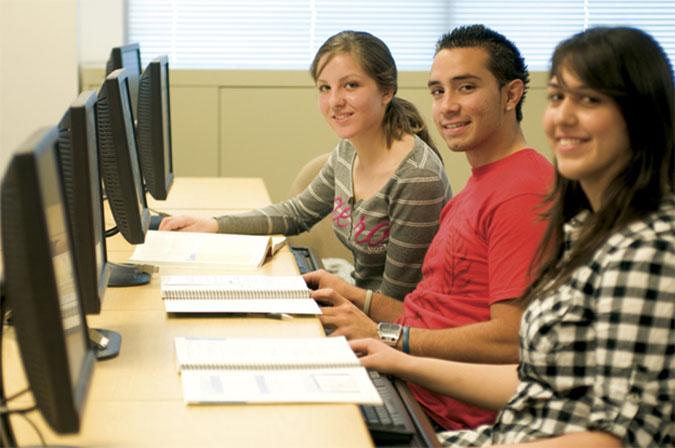Art Department
Animation

Program Overview
Students who wish to pursue an animation focused course of study at ELAC will find a wide range of course offerings that emphasize the techniques and tools used in new media professional settings. Our Animation courses cover everything from character and layout design to 3-d modeling and beyond, giving students the opportunity to work directly with the technology and programs used by professional animators. All animation faculty have experience working as professional animators.
ELAC Animation courses are available to all students, whether or not they plan to pursue a career in related fields. Future animators will find supportive and personalized instruction in their chosen area of interest.
Animation Course Descriptions (ANIMATN)
LECTURE, 2 HOURS; LABORATORY, 4 HOURS.
This course provides foundational character animation concepts. The concepts include key positions, breaking down movement, acting, takes, accents, gestures, dialogue, and facial expressions.
(3) CSU, Prerequisite: Art 201
LECTURE, 2 HOURS; LABORATORY, 2 HOURS.
This course focuses on the fundamentals of background layout with an emphasis on perspective, composition, design basics, staging, mood, texture and lighting. Students also learn the basics of using props as background and foreground design elements.
(3) CSU, Prerequisite: Art 201
LECTURE, 2 HOURS; LABORATORY, 2 HOURS.
This course focuses on applying industry-standard storyboarding and scripting techniques to animation. Contents to be covered include the various purposes and formats of storyboards, the basic terminology and concepts used in storyboarding, and the application of storyboarding techniques to the creation of storyboards with or without a written script. Research and visualization are emphasized.
(3) CSU
LECTURE, 2 HOURS; LABORATORY, 4 HOURS.
This course provides foundational animation concepts and experimental techniques. The concepts include squash and stretch, anticipation, overlapping action, analyzing, and depicting natural forces. The techniques introduced include drawing, puppet making, sand, paint, and cutouts, providing the basic principles of animation focusing on timing and weight through a series of projects.
(3) CSU, Prerequisite: Animation 218
LECTURE, 2 HOURS; LABORATORY, 3 HOURS.
This course exposes students to the process and production in animation and related industries. Topics covered include preproduction and production, as well as project management from concept to completion including scheduling, budget management, and team building.
(3) CSU
LECTURE, 2 HOURS; LABORATORY, 4 HOURS.
This advanced course introduces students to high-end three-dimensional animation software. Students acquire familiarity with the expansive interface. Students gain basic understanding and proficiency in 3-D modeling, texture, and animation. Basic animation concepts are reinforced and demonstrated through regular projects.
(3) CSU (Formally Animation 222), Prerequisite: Animation 221.
LECTURE, 2 HOURS; LABORATORY, 4 HOURS.
This course explores 3-D character animation, focusing on the 12 principles of traditional animation with emphasis on timing, weight, and performance. In addition, students are introduced to rigging a character using a skeleton, morph targets to create facial expressions, lip sync, and other animation techniques uniquely relevant to 3-D character animation including changes in translation, scale, and rotation through space in time as well as learning camera control and lighting techniques.
(3) CSU, (Formally Animation 223) Prerequisite: Animation 221
LECTURE, 2 HOURS; LABORATORY, 4 HOURS.
This course concentrates on 3-D animation techniques used in pre-production and production including cameras, lenses, mounting equipment, framing and composition, and natural and studio lighting as it applies to CGI. Students learn the difference between real cameras and 3D digital cameras, and create appropriate camera rigs to support the creation of digital animatics used in 3-D production.
(3) CSU, Prerequisites: Animation 225 and Animation 226.
LECTURE, 2 HOURS; LABORATORY, 4 HOURS.
This course concentrates on using advanced 3-D techniques to create, design and produce an animated 3-D project from concept to final edit. With the supervision of the instructor, students design, model, animate, render, and composite a project suitable for their portfolio while learning pre-production, production, and post-production pipelines and methods.
(4) CSU, Prerequisite: Animation 227
LECTURE, 2 HOURS; LABORATORY, 4 HOURS.
This course covers Virtual, Augmented, and Mixed Reality. Through lectures, demonstrations and hands-on lab exercises, students learn the concepts involved in creating experiences in room scale virtual reality. Topics include asset preparation from 3-D software such a Maya for use in the Unreal Engine, lighting systems in Unreal, special effects, material and texture preparation, animation, sound, layout of production assets and navigation in Unreal Engine for room scale virtual reality. Upon successful completion of this course, students understand the production pipeline for studio-based projects in both Entertainment and Game Design. They will understand the needs of employers in this emerging field.
(3) CSU, Prerequisite: Animation 221
LECTURE, 2 HOURS; LABORATORY, 4 HOURS.
In this class, students are able to expand on the subject of 3D model creation for games, animations, and visual effects as well as create more realistic 3D models, from hard surfaces to simple organic shapes. An emphasis is added to build models ready for animation and texturing.
(2) CSU, Prerequisite: Animation 221
LECTURE, 2 HOURS; LABORATORY, 4 HOURS.
This course provides an overview of the processes used to render digital images from 3D projects. Using industry-standard tools and methods, students learn to create photo-realistic and stylized renderings. Advanced shadowing, lighting, rendering, and compositing techniques are covered with an emphasis in photo realistic rendering.
(3) CSU
LECTURE, 2 HOURS; LABORATORY, 4 HOURS.
This course introduces students to the basics of compositing for motion graphics and visual effects, animation, and motion graphics. Students learn the basic techniques of compositing such as masking, layering, rotoscoping, chroma keying, tracking, matchmoving, and color timing.